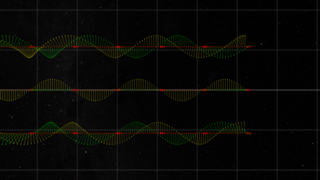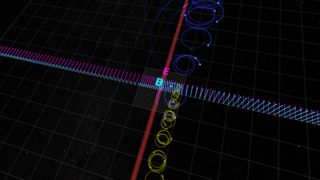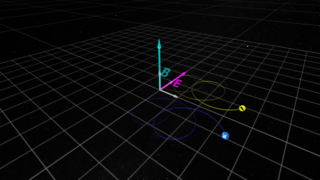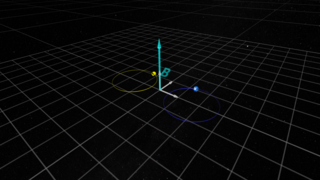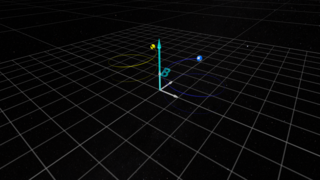Sun
ID: 4264
Motions of charged particles in electromagnetic fields are important in understanding the behaviors of plasmas in space. In Plasma Zoo, we present visualizations of particle motions in simple electromagnetic field configurations.
One of the more fundamental motions of charged particles in a magnetic field is gyro-motion, or cyclotron motion. If a charged particle is moving in a magnetic field, the particle experiences a force perpendicular to the direction of the charge motion and the field. This direction is determined by the Right-Hand Rule (Wikipedia). The resulting force directs the motion in a curve such that if we view along the direction the magnetic field is pointing, we will see the positive particles gyrate anti-clockwise while the negative particles gyrate clockwise.
In the previous examples (Plasma Zoo: Gyromotion in Two Dimensions, Plasma Zoo: Gyromotion in Three Dimensions and Plasma Zoo: Particle Drift in a Magnetic Gradient) we examined the motion of charged particles exclusively in magnetic fields, represented by cyan arrows and the letter 'B'.
In this example, we include a constant electric field, designated by a magenta arrow and the letter 'E', which will point in the same direction as the magnetic field.
We again include two charged particles of the same mass and speed and with positive ('+') and negative ('-') charge. As in the examples before, the charged particles are directed into circular motions (gyro-motion) by the magnetic field, moving around the circular path in opposite directions.
In this case, the electric field adds an additional motion. The positive charge ('+') accelerates in the direction of the electric field, so its path forms a helix with pitch that changes as the particle moves faster in the direction of the electric field (rather like stretching of a spring). The negative charge ('-') accelerates similarly, but in the opposite direction.
These motions combine to form a net (positive) current in the upward direction. This configuration is sometimes referred to as a field-aligned current in the literature. It may also be called a Birkeland current, after Kristian Birkeland (Wikipedia) who suggested their role in the formation of the aurora in the early 1900s.
Important Note: The example here shows particles with the same speed and mass. If the masses are different (for example, a positive proton has about 1836 times more mass than an electron), the radius of the gyromotion will be proportionally larger for the same speed.
A new version with a revised camera motion to better illustrate the charge particle motion along the electric field was added February 9, 2015.
Plasma Zoo: Field-Aligned Current (Birkeland Current)
One of the more fundamental motions of charged particles in a magnetic field is gyro-motion, or cyclotron motion. If a charged particle is moving in a magnetic field, the particle experiences a force perpendicular to the direction of the charge motion and the field. This direction is determined by the Right-Hand Rule (Wikipedia). The resulting force directs the motion in a curve such that if we view along the direction the magnetic field is pointing, we will see the positive particles gyrate anti-clockwise while the negative particles gyrate clockwise.
In the previous examples (Plasma Zoo: Gyromotion in Two Dimensions, Plasma Zoo: Gyromotion in Three Dimensions and Plasma Zoo: Particle Drift in a Magnetic Gradient) we examined the motion of charged particles exclusively in magnetic fields, represented by cyan arrows and the letter 'B'.
In this example, we include a constant electric field, designated by a magenta arrow and the letter 'E', which will point in the same direction as the magnetic field.
We again include two charged particles of the same mass and speed and with positive ('+') and negative ('-') charge. As in the examples before, the charged particles are directed into circular motions (gyro-motion) by the magnetic field, moving around the circular path in opposite directions.
In this case, the electric field adds an additional motion. The positive charge ('+') accelerates in the direction of the electric field, so its path forms a helix with pitch that changes as the particle moves faster in the direction of the electric field (rather like stretching of a spring). The negative charge ('-') accelerates similarly, but in the opposite direction.
These motions combine to form a net (positive) current in the upward direction. This configuration is sometimes referred to as a field-aligned current in the literature. It may also be called a Birkeland current, after Kristian Birkeland (Wikipedia) who suggested their role in the formation of the aurora in the early 1900s.
Important Note: The example here shows particles with the same speed and mass. If the masses are different (for example, a positive proton has about 1836 times more mass than an electron), the radius of the gyromotion will be proportionally larger for the same speed.
A new version with a revised camera motion to better illustrate the charge particle motion along the electric field was added February 9, 2015.
Related
Visualization Credits
Tom Bridgman (Global Science and Technology, Inc.): Lead Animator
Laurence Schuler (ADNET Systems, Inc.): Project Support
Ian Jones (ADNET Systems, Inc.): Project Support
David G. Sibeck (NASA/GSFC): Scientist
Thomas Moore (NASA/GSFC): Scientist
Laurence Schuler (ADNET Systems, Inc.): Project Support
Ian Jones (ADNET Systems, Inc.): Project Support
David G. Sibeck (NASA/GSFC): Scientist
Thomas Moore (NASA/GSFC): Scientist
Please give credit for this item to:
NASA's Scientific Visualization Studio
NASA's Scientific Visualization Studio
Short URL to share this page:
https://svs.gsfc.nasa.gov/4264
Data Used:
Note: While we identify the data sets used in these visualizations, we do not store any further details nor the data sets themselves on our site.
This item is part of this series:
Wave and Plasma Zoo
Keywords:
SVS >> Magnetic Fields
NASA Science >> Sun
GCMD >> Earth Science >> Sun-earth Interactions >> Ionosphere/Magnetosphere Dynamics >> Electric Fields/electric Currents
SVS >> Particles and Fields
GCMD keywords can be found on the Internet with the following citation: Olsen, L.M., G. Major, K. Shein, J. Scialdone, S. Ritz, T. Stevens, M. Morahan, A. Aleman, R. Vogel, S. Leicester, H. Weir, M. Meaux, S. Grebas, C.Solomon, M. Holland, T. Northcutt, R. A. Restrepo, R. Bilodeau, 2013. NASA/Global Change Master Directory (GCMD) Earth Science Keywords. Version 8.0.0.0.0
https://svs.gsfc.nasa.gov/4264
Data Used:
ParticleSimulator
ModelThis item is part of this series:
Wave and Plasma Zoo
Keywords:
SVS >> Magnetic Fields
NASA Science >> Sun
GCMD >> Earth Science >> Sun-earth Interactions >> Ionosphere/Magnetosphere Dynamics >> Electric Fields/electric Currents
SVS >> Particles and Fields
GCMD keywords can be found on the Internet with the following citation: Olsen, L.M., G. Major, K. Shein, J. Scialdone, S. Ritz, T. Stevens, M. Morahan, A. Aleman, R. Vogel, S. Leicester, H. Weir, M. Meaux, S. Grebas, C.Solomon, M. Holland, T. Northcutt, R. A. Restrepo, R. Bilodeau, 2013. NASA/Global Change Master Directory (GCMD) Earth Science Keywords. Version 8.0.0.0.0
